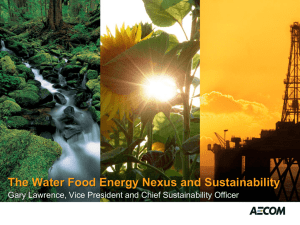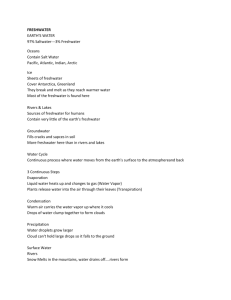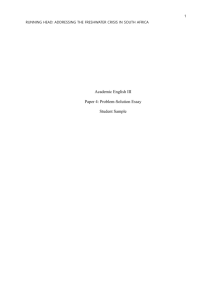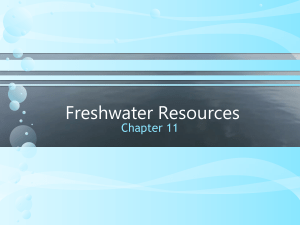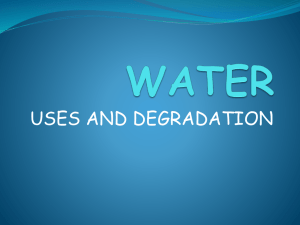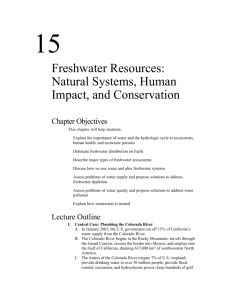chapter review 14
advertisement
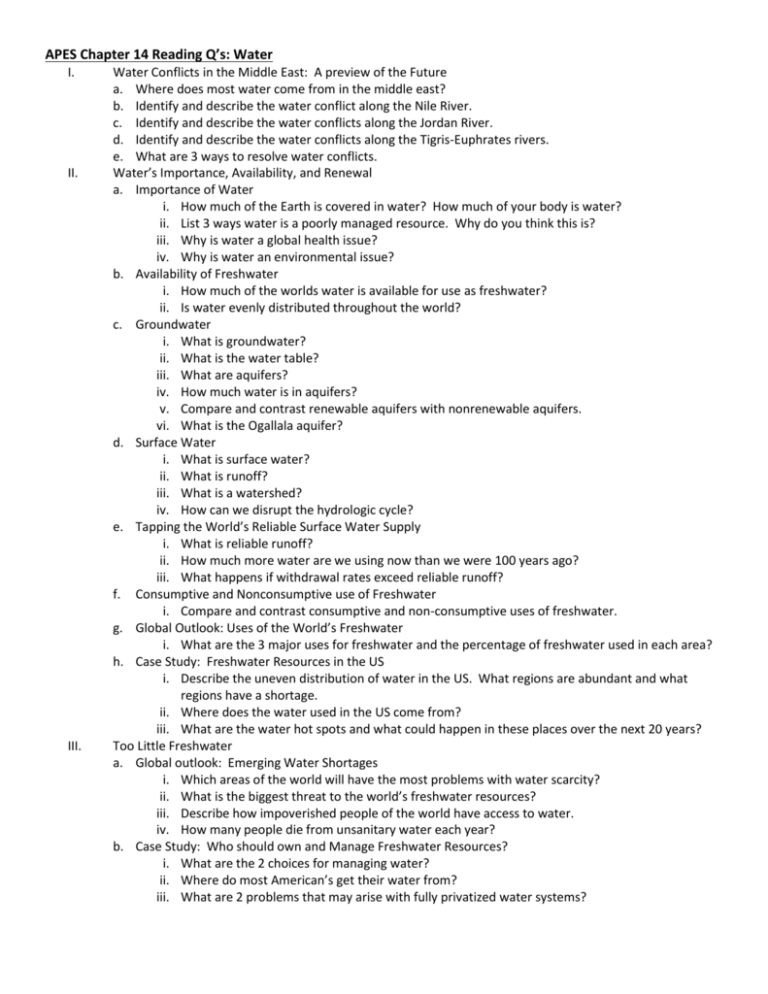
APES Chapter 14 Reading Q’s: Water I. II. III. Water Conflicts in the Middle East: A preview of the Future a. Where does most water come from in the middle east? b. Identify and describe the water conflict along the Nile River. c. Identify and describe the water conflicts along the Jordan River. d. Identify and describe the water conflicts along the Tigris-Euphrates rivers. e. What are 3 ways to resolve water conflicts. Water’s Importance, Availability, and Renewal a. Importance of Water i. How much of the Earth is covered in water? How much of your body is water? ii. List 3 ways water is a poorly managed resource. Why do you think this is? iii. Why is water a global health issue? iv. Why is water an environmental issue? b. Availability of Freshwater i. How much of the worlds water is available for use as freshwater? ii. Is water evenly distributed throughout the world? c. Groundwater i. What is groundwater? ii. What is the water table? iii. What are aquifers? iv. How much water is in aquifers? v. Compare and contrast renewable aquifers with nonrenewable aquifers. vi. What is the Ogallala aquifer? d. Surface Water i. What is surface water? ii. What is runoff? iii. What is a watershed? iv. How can we disrupt the hydrologic cycle? e. Tapping the World’s Reliable Surface Water Supply i. What is reliable runoff? ii. How much more water are we using now than we were 100 years ago? iii. What happens if withdrawal rates exceed reliable runoff? f. Consumptive and Nonconsumptive use of Freshwater i. Compare and contrast consumptive and non-consumptive uses of freshwater. g. Global Outlook: Uses of the World’s Freshwater i. What are the 3 major uses for freshwater and the percentage of freshwater used in each area? h. Case Study: Freshwater Resources in the US i. Describe the uneven distribution of water in the US. What regions are abundant and what regions have a shortage. ii. Where does the water used in the US come from? iii. What are the water hot spots and what could happen in these places over the next 20 years? Too Little Freshwater a. Global outlook: Emerging Water Shortages i. Which areas of the world will have the most problems with water scarcity? ii. What is the biggest threat to the world’s freshwater resources? iii. Describe how impoverished people of the world have access to water. iv. How many people die from unsanitary water each year? b. Case Study: Who should own and Manage Freshwater Resources? i. What are the 2 choices for managing water? ii. Where do most American’s get their water from? iii. What are 2 problems that may arise with fully privatized water systems? IV. V. VI. c. Spotlight: Water-Management Problems in Cochabamba, Bolivia i. Describe what happened to the water management system in Bolivia. Do you think that could happen in the US? d. Competition for the Worlds Water and Grain Resources i. What are three groups competing for the worlds grain and water supplies. e. What are our water options i. List 2 strategies to increase water supplies and 2 other strategies that could help us have more water. Withdrawing Groundwater to Increase Supplies a. Trade-offs: advantages and disadvantages of withdrawing groundwater i. List 3 advantages and 3 disadvantages of withdrawing groundwater. b. Groundwater Depletion: A growing problem i. Explain how this can become a tragedy of the commons. ii. What happens to food production when aquifers are overpumped? iii. How is China trying to prevent groundwater depletion? iv. Where has groundwater depletion taken place in the US? v. What kinds of government subsidies exist in the US that encourage groundwater depletion? vi. How many years of agriculture will Saudi Arabia have left? c. Other Effects of Groundwater Over-pumping i. Identify and describe with examples 3 other effects of groundwater over-pumping. d. Solutions: Using Aquifers more Sustainably i. List 3 ways we can prevent groundwater depletion and 3 ways we can control groundwater depletion. Using Dams and Reservoirs to Supply More Water a. Trade Offs: Advantages and Disadvantages of Large Dams and Reservoirs i. Using figure 14-13, list 3 advantages and 3 disadvantages of large dams. ii. What is the main purpose of dams? iii. Where are most of the dams in the world? iv. Describe how a dam can provide hydroelectric power. b. Case Study: The Colorado River Basin—an overtapped resource i. What states does the Colorado River pass through and where does it empty? ii. How many people use water from the Colorado? iii. What are the 4 major problems with using the Colorado River’s water? iv. What is most of the water used for? Does this make sense in the climate that the Colorado passes through? c. Case Study: China’s Three Gorges Dam (the things said to happen in the future in this section have happened) i. Where is this dam and why is it so special? ii. What are 3 good things about this dam? iii. What are three bad things about this dam? d. Dam Removal i. List 3 reasons why people want dams to be removed. Transferring Water from one place to Another (or, how we get water in Southern California) a. Advantages and Disadvantages of water transfers i. What is the biggest disadvantage of transferring water? b. Case Study: The California Experience i. Describe, in detail, the California Water Project. ii. What is happened to groundwater in southern California? iii. Describe what has happened to the water in the Central Valley? c. Case Study: The Aral Sea Disaster i. Where is the Aral Sea? ii. Describe, in detail, what happened to the Aral Sea? VII. VIII. IX. X. Desalting Seawater, Seeding Clouds, and Towing Icebergs and Giant Baggies a. Removing Salt from seawater i. What is Desalinization? ii. Explain distillation. iii. What countries have most of the desalinization plants? iv. What are 2 problems with desalinization? v. List 2 ways companies are trying to solve these problems. b. Cloud Seeding and Towing Icebergs or Gigantic Water Bags i. What is cloud seeding? ii. List 4 problems with could seeding. iii. Describe the giant water bag idea. Increasing Water Supplies by Wasting Less Water a. Benefits of reducing water waste i. How much water is lost through waste? ii. What is the main cause of water waste? iii. How have they combated this problem in South Africa? b. Solutions: Wasting Less water in Irrigation and Increasing Crop Yields i. Describe flood irrigation and why it is wasteful. ii. Describe center pivot irrigation. iii. Describe drip irrigation. iv. What are some problems with implementing drip irrigation systems? v. How can farmers change the way they grow rice to conserve water? c. Solutions: Getting More Water for Irrigation in Developing Countries: The Low-Tech Aproach i. List 4 ways poorer farms can conserve water. d. Solutions: Wasting Less water in Industry and Homes i. List 11 ways we can reduce water wasted in industries and homes. ii. Is water conservation for emergencies only? Support your anwer. e. Raising the Price of Water: A Key to Water Conservation i. Describe a tiered water pricing system. f. Solutions: Using Less Water to Remove Industrial and Household Wastes i. Explain how we use water to remove household waste. ii. Describe 2 ways we could use less water to remove waste. Too Much Water a. Flooding i. What is a floodplain? ii. Identify 2 ways we have reduced the number of floods that occur. iii. What are 2 benefits of floods? iv. What are 2 human activities that have increased the number of deaths and damage from floods? v. Why was the damage from Hurricane Katrina intensified? vi. How can we prevent further devastation in the Gulf? b. Case Study: Living on Floodplains in Bangladesh i. How have the people of Bangladesh increased the amount of flooding that occurs there. c. Solutions: Reducing Flood Risks i. List 4 ways to prevent flood damage and 3 ways to control flood damage. ii. Why have people criticized US flood insurance? Solutions: Using Water More Sustainably a. Summarize 5 ways that we can have a blue revolution. b. List 5 ways you can conserve water.





